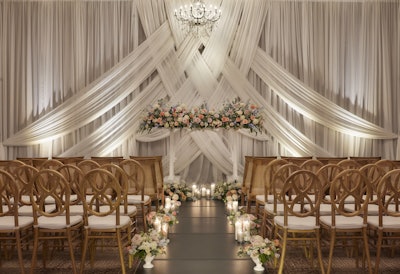
Sponsored content from Quest Events.
The events industry is no stranger to change. It continually adapts to new trends, demands, and challenges. And one of the most pressing challenges recently is balancing sustainability and longevity in selecting event draping materials.
Event draping is not only essential for the aesthetics of an event but also plays a crucial role in its functionality. So, how can we ensure that our choices in draping materials are eco-friendly and durable in the long run?
Traditional draping materials have a remarkable history because of their timeless appeal, practicality, and exceptional durability.
- Polyester has become a staple in the events industry for good reason. Its durability allows for multiple uses across many years. Although it originates from petroleum, it can be eco-friendly when considering its entire lifecycle.
- Nylon is known for its strength and resilience; nylon drapes are designed to last. While its production has environmental considerations, the material's longevity can offset its initial ecological footprint.
- As a natural choice, cotton brings a classic touch to events. Cotton can be eco-friendly and durable when sourced responsibly and used over extended periods.
The Real Environmental Impact of Traditional Materials
The true environmental advantage of traditional materials lies in their longevity. By serving multiple events over many years, these drapes reduce the production, transportation, and disposal frequency associated with less durable alternatives.
The environmental impact of a product should be considered over its entire lifecycle. Drapes that last for decades are often more environmentally friendly than materials requiring frequent replacements. Proper care can extend the life of even the most durable materials, enhancing their sustainability profile. This involves keeping drapes clean, preserving their aesthetic appeal, and preventing wear and tear.
Using eco-friendly cleaning solutions ensures that the drapes remain environmentally friendly throughout their life. Storing drapes in cool, dry places and using protective covers can prevent damage, ensuring they stay in prime condition for many years. Instead of discarding slightly damaged drapes, consider repairing them. Minor tears or issues can often be fixed, giving the drape a new lease on life.
Incorporating Sustainability in Event Design and Planning
Integrating sustainability into the design and execution of events is the next step. This can include opting for waterless dyeing processes or eco-friendly dyes that reduce the environmental impact of coloring drapes. It also requires modern manufacturing techniques to produce polyester, nylon, or cotton using less energy, minimizing the carbon footprint. Ensuring natural fabrics like cotton are sourced from farms with certified sustainable practices can also make a significant difference.
A sustainable future in the events industry depends on a circular economy, which focuses on reusing and recycling resources to the fullest. Efficient utilization and rotation of drapes and effective inventory management can optimize the return on investment and reduce the need for new purchases.
The events industry can embrace sustainability while maintaining the aesthetics and functionality of event draping. By choosing durable traditional materials, caring for them properly, incorporating sustainable practices, and exploring innovative solutions, the industry can create memorable and responsible events that stand the test of time.



















